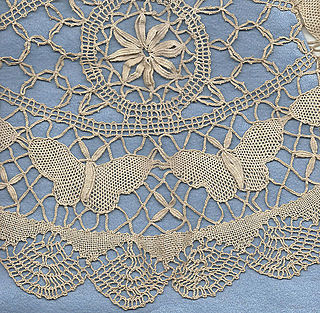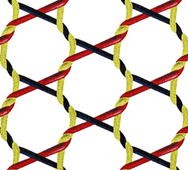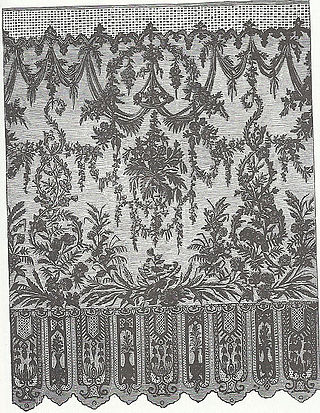
Lace is a delicate fabric made of yarn or thread in an open weblike pattern, made by machine or by hand. Generally, lace is split into two main categories, needlelace and bobbin lace, although there are other types of lace, such as knitted or crocheted lace. Other laces such as these are considered as a category of their specific craft. Knitted lace, therefore, is an example of knitting. This article considers both needle lace and bobbin lace.

Bobbin lace is a lace textile made by braiding and twisting lengths of thread, which are wound on bobbins to manage them. As the work progresses, the weaving is held in place with pins set in a lace pillow, the placement of the pins usually determined by a pattern or pricking pinned on the pillow.

A bobbin or spool is a spindle or cylinder, with or without flanges, on which yarn, thread, wire, tape or film is wound. Bobbins are typically found in industrial textile machinery, as well as in sewing machines, fishing reels, tape measures, film rolls, cassette tapes, within electronic and electrical equipment, and for various other applications.

Guipure lace is a type of bobbin lace. It connects the motifs with bars or plaits rather than net or mesh.

Bobbinet tulle or genuine tulle is a specific type of tulle which has been made in the United Kingdom since the invention of the bobbinet machine. John Heathcoat coined the term "bobbin net", or bobbinet as it is spelled today, to distinguish this machine-made tulle from the handmade "pillow lace", produced using a lace pillow to create bobbin lace. Machines based on his original designs are still in operation today producing fabrics in Perry Street, Chard, Somerset, UK.

Brussels lace is a type of pillow lace that originated in and around Brussels. The term "Brussels lace" has been broadly used for any lace from Brussels; however, strictly interpreted, the term refers to bobbin lace, in which the pattern is made first, and the ground, or réseau added, also using bobbin lace. Brussels lace is not to be confused with Brussels point, which is a type of needle lace, though sometimes also called "Brussels lace".

Torchon lace is a bobbin lace that was made all over Europe. It is continuous, with the pattern made at the same time as the ground. Typical basic stitches include whole stitch, half stitch, and twists, and common motifs include spiders and fans. Torchon lace was notable historically for being coarse and strong, as well as consisting of simple geometric patterns and straight lines. It did not use representational designs, for the most part.

Battenberg lace is a type of tape lace. It is of American origin, designed and first made by Sara Hadley of New York. This American lace was named either in honor of the wedding of Princess Beatrice, Queen Victoria's youngest daughter, to Prince Henry of Battenberg, or from [sic] the widowed Princess Beatrice. It is made using bobbins and needles, or just needles alone.The original Battenberg lace used just one stitich: buttonhole picot. Other stitches that were later used include flat wheel and rings or "buttons".

Lace machines took over the commercial manufacture of lace during the nineteenth century.

Maltese lace is a style of bobbin lace made in Malta. It is a guipure style of lace. It is worked as a continuous width on a tall, thin, upright lace pillow. Bigger pieces are made of two or more parts sewn together.

Tape lace is made with a straight tape which is bent into the shape required and sewn into position. Various needle lace fillings may be used to fill the gaps. The tape is usually machine made. This type of lace is also known as mixed tape lace, or mixed lace, as it uses more than one technique: one in making the tape, and a different technique for the fillings and joins.

Part lace or sectional lace is a way of making bobbin lace. It characterises various styles, such as Honiton lace or Brussels lace.

Russian lace is a bobbin tape lace. The tape is made with bobbins at the same time as the rest of the lace, curving back on itself, and joined using a crochet hook. It was made in Russia, but similar laces made elsewhere are also called Russian lace.

Bayeux lace was bobbin lace that was made at Bayeux in Normandy, France.

Idrija lace is a bobbin tape lace, native to Slovenia. The tape is made with bobbins at the same time as the rest of the lace, curving back on itself, and joined using a crochet hook.
Schneeberg lace is a bobbin tape lace. The tape is made with bobbins at the same time as the rest of the lace, curving back on itself, and joined using a crochet hook. This type of lace is developed about 1910 in Schneeberg.

Rosaline lace is a late 17th-century Venetian needle lace, and a late 19th-century bobbin part lace imitation. A Brussels variant with needle lace pearls is called Rosaline Perlée. The variant made in Bruges lacked the pearls.

The lace curtain machine is a lace machine invented by John Livesey in Nottingham in 1846. It was an adaptation of John Heathcoat's bobbinet machine. It made the miles of curtaining which screened Victorian and later windows.

Ipswich lace is a historical fashion accessory, the only known American hand-made bobbin lace to be commercially produced. Centered in the coastal town of Ipswich, Massachusetts north of Boston, a community of lacemaking arose in the 18th century. Puritan settlers to the area likely made and wore lace as early as 1634, because Sumptuary laws from the early colonial records indicate this activity. In fact, the earliest known record of the act of lacemaking in the region comes from a court case in 1654 associated with the home of Governor John Endicott. An indentured servant in the household accused the governor's son Zerubbabel with assault, which occurred while she was working at her lace cushion. Earliest known records of the commercial production indicate that lace produced by local women was used to barter for goods in the 1760s, as denoted by ledger account books belonging to local merchants. These laces were sold in the region from Boston to Maine.

Milanese bobbin lace is a textile used as a fashion accessory or a decorative trim, first becoming popular in the 17th and 18th centuries in Milan. Lacemaking was an important economic activity in Northern Italy, besides touching on social status matters as well as being a culturally significant art form. The earliest versions of the lace consisted of the tape mostly filling the space. Typical characteristics of Milanese bobbin lace are scrolls made with curving clothwork tapes and floral motifs, and sometimes also consisting of human or animal figures. Sometimes needle lace techniques were combined with the bobbin lace pieces to create the final product.




















